(Last Updated On: October 4, 2021)
There are many different types of questions that educators can use to assess learning outcomes. However, it might be a challenging task for writing good test questions measuring learners’ capability correctly. This article will explain in detail some rules for writing Multiple Choice Questions, one of the most widely used methods for testing learners’ knowledge.
 Basically, multiple choice questions are pick-one questions having only one correct answer. Other choices act as the “distractors” which are meant for drawing learners’ attention away from the real answer. Every multiple choice question contains two parts: stem and alternatives. Particularly, the stem is the question part comprising the problem that needs to be solved. While alternatives part consists of the various options from which learners choose one correct answer.
Now, keep reading to explore some rules for designing stem and alternatives in detail.
Basically, multiple choice questions are pick-one questions having only one correct answer. Other choices act as the “distractors” which are meant for drawing learners’ attention away from the real answer. Every multiple choice question contains two parts: stem and alternatives. Particularly, the stem is the question part comprising the problem that needs to be solved. While alternatives part consists of the various options from which learners choose one correct answer.
Now, keep reading to explore some rules for designing stem and alternatives in detail.
 To pick an answer to this question, learners have to analyze and find out the rule of the series.
To pick an answer to this question, learners have to analyze and find out the rule of the series.







 Basically, multiple choice questions are pick-one questions having only one correct answer. Other choices act as the “distractors” which are meant for drawing learners’ attention away from the real answer. Every multiple choice question contains two parts: stem and alternatives. Particularly, the stem is the question part comprising the problem that needs to be solved. While alternatives part consists of the various options from which learners choose one correct answer.
Now, keep reading to explore some rules for designing stem and alternatives in detail.
Basically, multiple choice questions are pick-one questions having only one correct answer. Other choices act as the “distractors” which are meant for drawing learners’ attention away from the real answer. Every multiple choice question contains two parts: stem and alternatives. Particularly, the stem is the question part comprising the problem that needs to be solved. While alternatives part consists of the various options from which learners choose one correct answer.
Now, keep reading to explore some rules for designing stem and alternatives in detail.
Rules for Writing Stem
Rule #1: Checking Comprehension and Improve Higher-level Thinking
When it comes to improving learners thinking, it reminds us of Bloom’s Taxonomy theory. According to Bloom, there are six levels within the cognitive domain: Remember, Understand, Applying, Analyze, Evaluate and Create. This means the last goal of using different question types in the lesson not only to remember or understand knowledge but also to judge and create new things. Hence, multiple choice questions have to take on many tasks. Checking comprehension as well as helping learners develop their higher-level thinking such as problem-solving, critical thinking, creativity. So, don’t waste time with the questions assessing knowledge of trivial facts. Here’s a simple question to test learners thinking: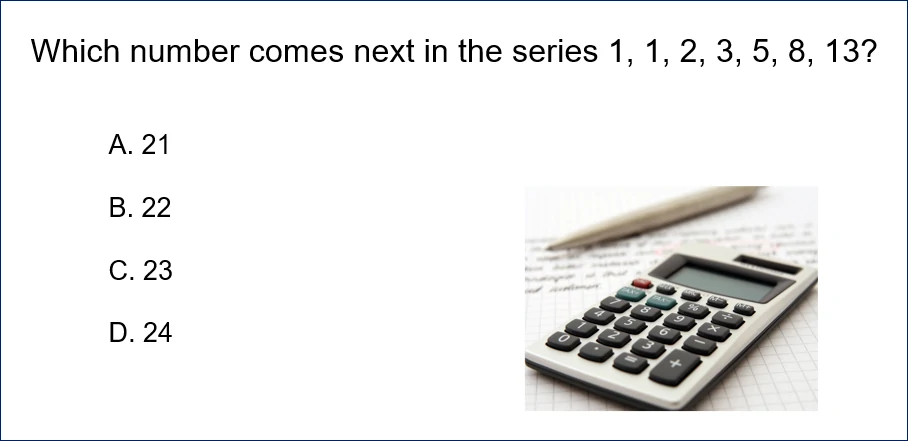 To pick an answer to this question, learners have to analyze and find out the rule of the series.
To pick an answer to this question, learners have to analyze and find out the rule of the series.
Rule #2: Using the Question Format
On the whole, it is a good way to start the multiple choice questions with question words. If you want to test learners’ factual knowledge, you can use “what”, “who”, “when” and “where” questions. Additionally, “which”, “why” and “how” questions are recommended to test learners’ applying and analyzing knowledge. Using simultaneously question words with simple structure help learners have a clear orientation on what they should find out in the answers. Moreover, “The stem would be presented in the form of a clear and complete question, focusing on getting a clear answer rather than holding a partial sentence” (Statman, 1988). In other words, a full sentence ending with a question mark is preferable to a sentence with a blank. For example, it is a less effective stem that: “Black cabs” is famous in __________. Now, we need to restructure the sentence like this:
Rule #3: Expressing Full Information
This means that the stem should be meaningful by itself and show the problem plainly. That would be great when learners can answer your question without looking at the options. As a matter of fact, if a stem doesn’t present a problem clearly, it may be ambiguous for learners to answer or even become daunting. In addition, the question stem should be placed most of the words to make answer options shorter. This way, the answer options can be short with key words to make learners more legible. For example, it’s not wise when giving this question to learners: Which of the following statements is true? A. Melbourne is known as the Fashion Capital of the World. B. Milan is known as the Fashion Capital of the World. C. St Petersburg is known as the Fashion Capital of the World. D. Rome is known as the Fashion Capital of the World. So, if you want to see a better change, here is a suggestion: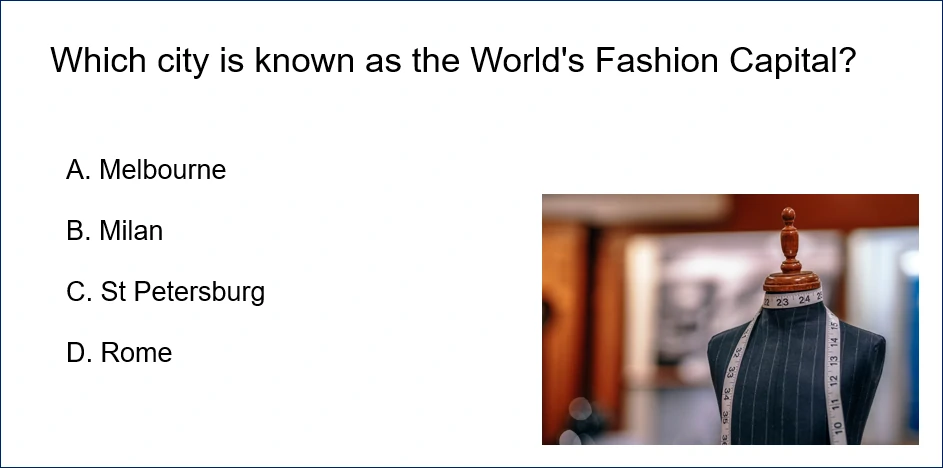
Rule #4: Removing Unnecessary Information
As said earlier, the question stem should contain sufficient information. However, sufficiency does not mean including too many things, even unnecessary information. In many pieces of research, multiple choice questions are highly assessed by their versatility, reliability, and validity. Thus, if you put many unnecessary materials in stem, it “can decrease the reliability and validity of the test scores” (Haladyna and Downing, 1989). Let’s see the example below as a bad multiple choice question: Nowadays, there are many types of pollution. Air pollution is one of the biggest threats to the environment and affects everyone: humans, animals, crops, cities, forests, aquatic ecosystems… Air pollution can be decreased when we: A. Use private vehicles B. Burn fossil fuels C. Use public transportation D. Cut down trees and forest A better suggestion is: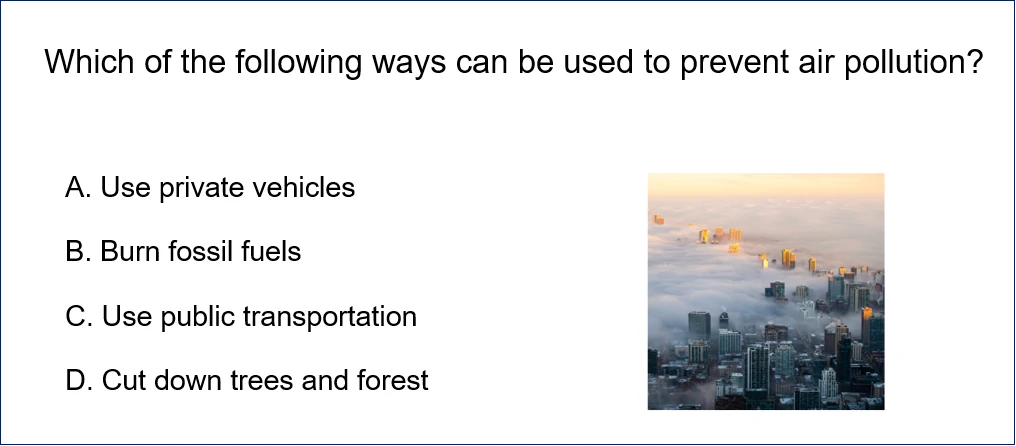
Rule #5: Avoiding Negative Word
Learners often have difficulty understanding items with negative phrasing (Rodriguez, 1997). If test-takers are familiar with the material, the negative words can confuse them because they don’t initially observe it. As a result, they may make mistakes when answering negatively worded stems. However, in case you must use it, highlight the negative word in uppercase or bolding them so that it is obvious to learners. So, instead of writing: Which country does not have a king or queen? It is better for writing like this: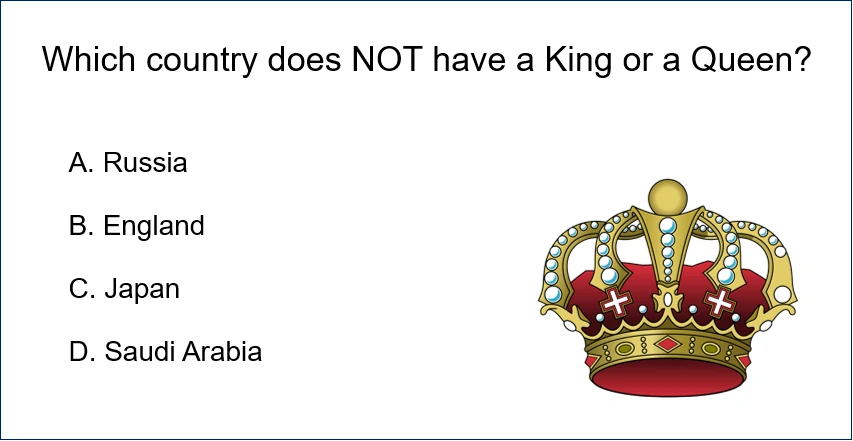
Rules for Writing Alternatives.
Rule #1: Using Only One Best Answer
As mentioned before, multiple choice questions are questions type having one-best-answer-items. So, there should be only one option that is clearer than the other options. If not, it will make learners confused and difficult to decide which is most correct. For example, four options in the below picture make learners bewildered which more correct. Neither is correct all of the time.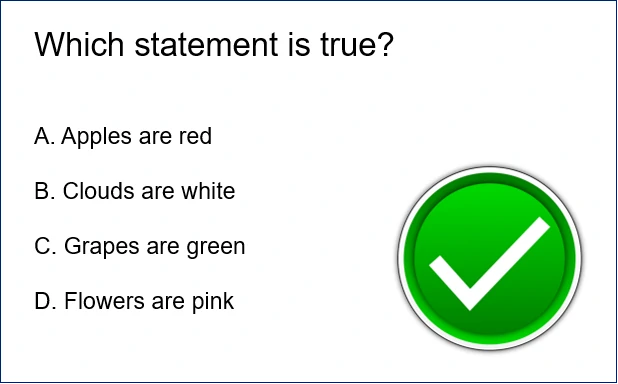
Rule #2: Making Options Similar in Grammar and Length
Undoubtedly, alternatives should be stated clearly and concisely. Thus, make sure all the options are grammatically parallel to each other. This will make learners think carefully to find the correct answer instead of basing on grammar mistakes. What’s more, don’t use answer length as a hint to find the correct option. In some cases, learners tend to guess the answer depends on its length. Often the longest is the most correct. However, if you cannot manage all four options to the same length, use two long and two short. Here is an example of a question with parallel grammatical answers:
Rule #3: Keeping the Distractors Plausible
It is clear that the function of the incorrect options is to distract learners’ attention. Thus, you may evaluate who is comprehends and concentrate on the course content. If the distractors are farfetched, test-takers will locate the correct answer with ease, even if they have little knowledge. So, making all options plausible to avoid learners guessing the correct answer. In this example, it’s quite easy for learners to realize the difference between all options and it is unlikely that learners would pick the options A, C, or D. What is NOT the benefit of the forest? A. Increase soil erosion B. Cleaning the air C. Providing oxygen D. Reducing climate change A better alternatives part should be: